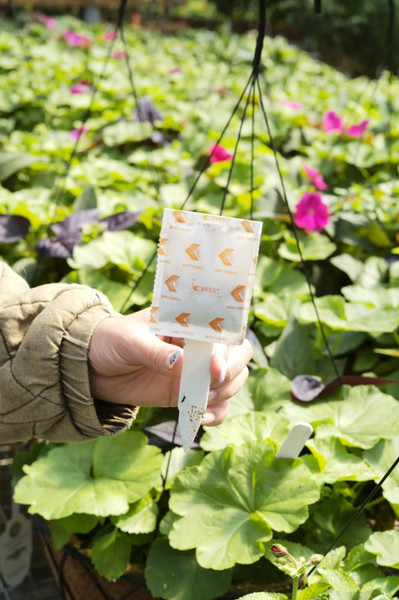Beneficial Insects
Posted by Jessie Jacobson on Apr 4th 2022
Tonkadale Uses Beneficial Insects to Control Greenhouse Pests
Beneficial insects and mites, or “beneficials”, are used in many greenhouses, including Tonkadale, to control pests. Beneficials are part of an overall pest management strategy known as integrated pest management, or IPM. One of the primary purposes of IPM is to control pests while using less chemicals, to reduce environmental impact, and improve human safety. Beneficial insects and mites are useful because they are safe, environmentally friendly, and effective.
Tonkadale uses many beneficials
to control pests year-round.
In the Spring, we add sachets containing Neoseiulus cucumeris mites to our hanging baskets. Neoseiulus is a small, nearly microscopic mite which feeds on the insect pest thrips. The sachets contain around 500 of the Neoseilus mites which disperse onto the flowers and leaves of the basket.
Later in the year, when temperatures are higher, we apply an alternative mite, Amblyseius swirskii, onto our plants. Amblyseius swirskii also feeds on adult thrips. We change mites because Amblyseius is more suited than Neoseiulus to surviving in the high, summertime temperatures of the greenhouse.
Aphids are another pest in greenhouses for which beneficials can be used for control. You may have seen buckets beneath the tables at Tonkadale. These contain Aphidius colemani, a type of parasitic wasp which preys on aphids. Aphidius is a tiny wasp which inserts its eggs inside of adult aphids. The egg hatches and the wasp consumes the inside of the aphid. Aphids parasitized by Aphidius become hollow, tan or brown husks. The buckets beneath the tables at Tonkadale give the wasp larvae a safe place to hatch, before they fly off in search of aphids.
Also beneath the tables at Tonkadale are colonies of the beneficial mite, Stratiolaelaps scimitus. Stratiolaelaps is a soil-dwelling “generalist” beneficial, meaning it feeds on and controls multiple pests. Some pests, such as thrips and fungus gnats, pupate or develop, in damp soil. While Neosilus and Amblyseius are applied to our plants to control adult thrips, Stratiolaelaps feeds on the pupae and larvae of these pests on the ground below the plants. Early each year, we receive containers of peat each containing 50,000 stratiolaelaps mites. The peat is deposited under our tables, allowing the mites to disperse before the pests can establish their own populations in the soil. The peat is also added to the soil in our hanging baskets for the same purpose.
Another pest, more common on citrus, palms, and certain houseplants, is the two-spotted spider mite. The two-spotted spider mite is a particularly pernicious pest which resists many chemical pesticides. Phytoseiulus persimilis is an excellent predator and beneficial mite which feeds exclusively on two-spotted spider mites. On plants where spider mites are likely to develop, or are already present, we hang cardboard “Diboxes” containing vermiculite and Phytoseilus mites. The Phytoseiulus mites move off the vermiculite, along the box and onto the foliage in search of their food source, the spider mite. Phytoseilus is a very effective control method for spider mites and can eradicate a spider mite population in a short period.
Certain seasonal crops, such as poinsettia, have their own unique pests like whiteflies. During the later months of growing poinsettias, Tonkadale uses two other parasitic wasps, Eretmocerus eremicus and Encarsia formosa, to keep the poinsettias free of whiteflies. Like Aphidius, Eretmocerus and Encarsia insert their eggs into the pest. The eggs hatch and the juvenile wasp consumes the inside of the whitefly.
For the retail customer, Tonkadale has offered Heterorhabditis bacteriophora, a nematode, for control of Japanese Beetle grubs. While not an insect, Heterorhabditis functions as a beneficial, to eliminate Japanese Beetles. The nematodes are packed into a water-soluble gel which is mixed with water and applied onto soil where Japanese Beetle grub damage is present. After application and irrigation, the nematodes move downward through the soil to infect and kill the grubs. This not only controls the damage caused by the grubs feeding on turf roots, but also reduces the pressure of adults feeding the following year.
Tonkadale uses other bio-friendly pest controls, such as entomopathogenic fungi and insecticidal soaps, as part of our strategy to provide quality plants while respecting the environment.
We are hopeful that in the future, more high-quality, beneficial insects will be available for home gardeners and plant parents to aid in control of common insect pests.

